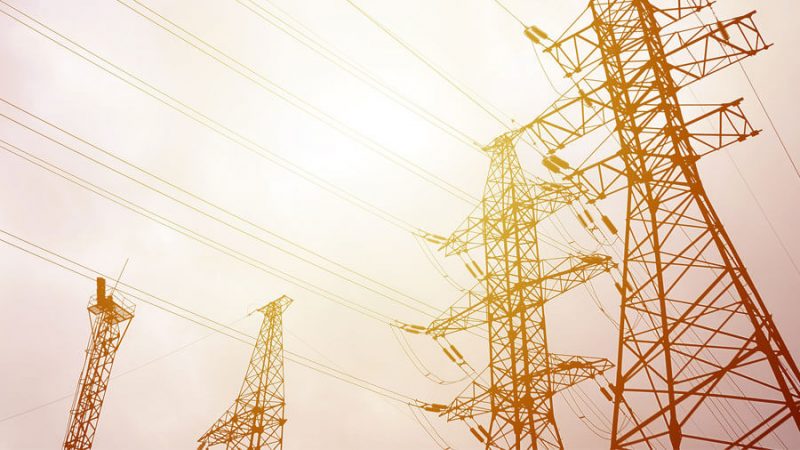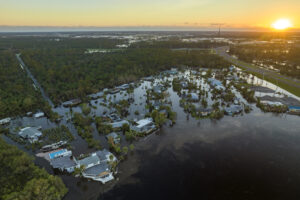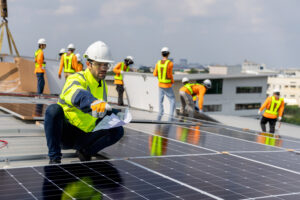An enormous drought does more than just strip us of freshwater. Major droughts (like the one we’re entering soon) causes a huge strain on our electrical grids. For every drought, there is typically extremely hot weather. When there’s hot weather – we turn on our AC units to the max. When we each turn on those air conditioning units, we put a minor strain on our electrical grids. From each minor strain, we build up to a major outage, and families, communities, and whole cities can lose power.
However, there is one solution that can help us stay cool indoors while preserving our grid’s integrity and fight climate change at the same time. We use the sun.
Seems peculiar right? How can the almighty and furiously hot sun help us during a time where water wells are running dry in the Western United States? Let’s just be clear, no – the sun cannot give us more water. But it can give us one thing we desperately need – energy. Energy that can be used to power our homes, our buildings, our facilities, our manufacturing plants, and more.
The solution has been and will continue to be solar energy. With each passing year, we are recording higher temperatures than ever before. Renewable energy resources such as wind and water can only do so much. For example, the Hoover Dam, which produces 4 billion kilowatt-hours of power for Nevadians, Arizonians, and Californians is now currently operating at all-time record lows.
In the case of a drought, hydroelectric power cannot be called upon to power our homes and enterprises.
Wind power and solar power are amongst the two renewable energy resources that are unaffected by drought. Here’s the thing – as a business, will you be able to build/maintain a windmill to power your facilities?
Now that we’ve ruled wind and water power out – all that’s left is solar energy. An abundant energy resource that comes out every day (and with a few technical applications, can energize your warehouse, plants, and buildings during the night as well).
In this article, we are going to be discussing how solar energy will present a major benefit for businesses and facilities worldwide during incredible periods of heat and drought.
Solar Energy in the Long Run
One of the greatest benefits of switching to solar energy is the fact that you can reduce your energy costs immediately. Any business owner would agree that reducing overhead costs will lead to better profit margins. By going green with solar energy, you’re basically saving green as well.
By stabilizing the costs of your energy in the long run through with solar power – you’re protecting yourself from energy price hikes. States such as Texas have the highest annual rise in energy cost – with a 4.1% rise in costs per year. If the state of Texas were to implement solar power earlier, then their grid might have survived long enough to be repaired before multiple crises started to happen.
This will give your business longer-term financial security, as you will know with certainty how much your business will spend (or save) regarding energy. If you don’t take our word for it – see what law firm Baker Mckenzie has to say, “the primary motivation behind renewable PPAs (solar energy power agreements) is economic, with green/sustainable advantages as a runner up. Some 60% of surveyed corporates exploring renewable PPAs cited economic factors as their primary reason for doing so.”
But how does this solve grid overload issues amid a drought?
Well…
When you incentivize solar energy as a tool to save on energy costs, you are giving a business with buildings and facilities a reason to not strain the electrical grid. They are now using renewable energy that is overabundant – and in most cases, are returning energy back into the grid.
Why place pressure on the grid during a record year in rising temperatures when you can produce the energy that powers your air conditioning with solar energy?
Furthermore, solar energy is drought-proof. If there is less water, the sun will still be shining, and producing the energy you need without the hassle. We are slowly becoming more independent from fossil fuels. And as this current drought has proven, we can’t always rely on hydroelectric power either.
As an added plus…
Energy storage systems can store any additional energy your solar panels create throughout the day that you don’t use. The benefits of an energy storage system working in tandem with your solar energy system are immense.
Your facilities are now mini-power plants, as they can create and store their own energy. This allows you to have energy during blackouts from grid overloads, freak accidents, and mother nature. Especially droughts. Your workers can work freely, with the air conditioning on – without having to worry about overloading an already strained electrical grid. As an added plus, energy storage systems allow you to use your stored up energy at night, for those hot summer evenings.
If there’s anything this drought has taught us, it’s that climate change is happening. At a global level, if facilities would adopt solar energy, we would be reducing the effects of global warming. By reducing its effects, we will reduce the number of droughts, hurricanes, fires, and habitat destruction all over the planet.
It pays to use solar energy, and as a byproduct – you will be saving the Earth as well. A future where there aren’t record temperatures in the summers, and snowstorms in the middle of Texas.
In conclusion
Solar energy proves both resilient and economically viable for investment. It’s capable of powering facilities, homes, and communities without cost-related concerns or grid strain caused by weather fluctuations. The drought highlights our reliance on electrical systems for cooling amid rising temperatures, exacerbated by insufficient water levels for dam operation.
Just imagine if the entire world switched to solar energy. Grid overloads, and climate change, would be a thing of the past.




